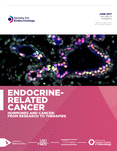Bisphenol A and its analogues disrupt centrosome cycle and microtubule dynamics in prostate cancer
- 1Department of Environmental Health, University of Cincinnati Medical Center, Cincinnati, Ohio, USA
- 2Center for Environmental Genetics, University of Cincinnati Medical Center, Cincinnati, Ohio, USA
- 3Cincinnati Cancer Center, Cincinnati, Ohio, USA
- 4Cincinnati Veteran Affairs Hospital Medical Center, Cincinnati, Ohio, USA
- 5Center for Cancer Research, Hudson Institute of Medical Research, Clayton, Victoria, Australia
- 6Monash University, Clayton, Victoria, Australia
- Correspondence should be addressed to S-M Ho or P Tarapore; Email: shuk-mei.ho{at}uc.edu or pheruza.tarapore{at}uc.edu
Abstract
Humans are increasingly exposed to structural analogues of bisphenol A (BPA), as BPA is being replaced by these compounds in BPA-free consumer products. We have previously shown that chronic and developmental exposure to BPA is associated with increased prostate cancer (PCa) risk in human and animal models. Here, we examine whether exposure of PCa cells (LNCaP, C4-2) to low-dose BPA and its structural analogues (BPS, BPF, BPAF, TBBPA, DMBPA and TMBPA) affects centrosome amplification (CA), a hallmark of cancer initiation and progression. We found that exposure to BPA, BPS, DMBPA and TBBPA, in descending order, increased the number of cells with CA, in a non-monotonic dose–response manner. Furthermore, cells treated with BPA and their analogues initiated centrosome duplication at 8 h after release from serum starvation, significantly earlier in G-1 phase than control cells. This response was attended by earlier release of nucleophosmin from unduplicated centrosomes. BPA-exposed cells exhibited increased expression of cyclin-dependent kinase CDK6 and decreased expression of CDK inhibitors (p21Waf1/CIP1 and p27KIP1). Using specific antagonists for estrogen/androgen receptors, CA in the presence of BPA or its analogues was likely to be mediated via ESR1 signaling. Change in microtubule dynamics was observed on exposure to these analogues, which, for BPA, was accompanied by increased expression of centrosome-associated protein CEP350. Similar to BPA, chronic treatment of cells with DMBPA, but not other analogues, resulted in the enhancement of anchorage-independent growth. We thus conclude that selected BPA analogues, similar to BPA, disrupt centrosome function and microtubule organization, with DMBPA displaying the broadest spectrum of cancer-promoting effects.
- endocrine-disrupting chemicals
- bisphenol A analogues
- BPA
- BPS
- BPF
- TBBPA
- DMBPA
- TMBPA
- centriole duplication
- prostate cancer
- Received 15 December 2016
- Accepted 19 December 2016
- Made available online as an Accepted Preprint 20 December 2016
- © 2017 Society for Endocrinology












